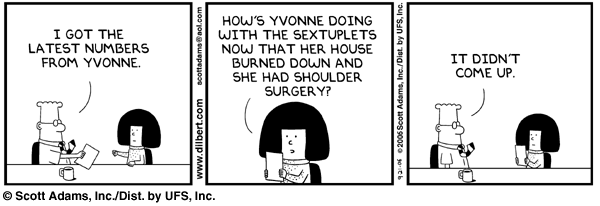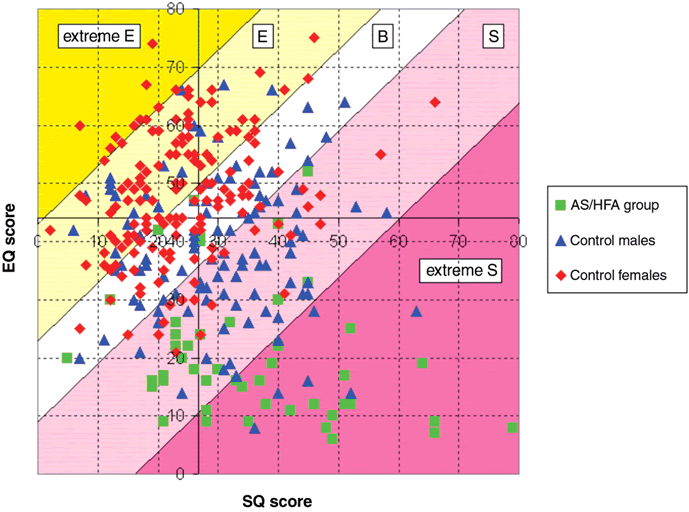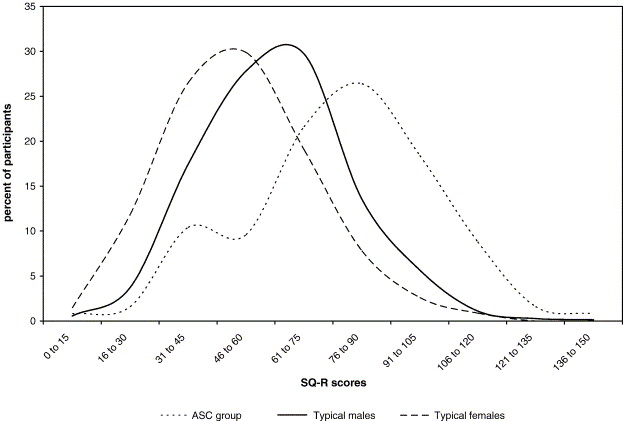September 24, 2006
Stereotypes and facts
"Many women find biological comfort in one another's company, and language is the glue that connects one female to another." That's what Louann Brizendine wrote in The Female Brain, and this idea resonates with many people, including me. At least, I think I recognize the corollary illustrated in this Dilbert strip (9/21/2006):
Perfect, right? Dilbert was focused entirely on the job -- on the numbers! Tina immediately thinks -- and asks! -- about the striking events of Yvonne's personal life. Maybe Dilbert didn't even know about the sextuplets, the fire, and the surgery, or maybe he knew and didn't ask for an update. Either way, he's a poster child for what Simon Baron-Cohen identifies as the "systematizing" tendencies of the male brain, while Tina represents the "empathizing" tendencies of the female brain.
I've recently devoted some effort to debunking exaggerated or outright false characterizations of sex differences. For example, the "biological comfort" quote from The Female Brain was followed by a series of striking overgeneralizations, unsupported by the references given in Brizendine's end-notes, as discussed in mind-numbing detail in "The main job of the girl brain" (9/2/2006). A list of other Language Log posts debunking brain-sex claims can be found here. And in today's Boston Globe Ideas section, I have a short piece fact-checking a couple of specific speech-related claims from The Female Brain ("Sex on the brain", 9/24/2006).
But that Dilbert strip has a particular resonance for me, because I worked for 15 years in an industrial research lab where most of the engineers were male, and all of the secretaries were female. News about people's lives generally reached me through the secretaries. I left that job 16 years ago, but I still feel that keeping up with colleagues' personal lives is something that comes more naturally to women than to men.
Is that feeling a valid one? In the lab where I worked, sex was largely conflated with job description. And in Dilbert's department, Tina is the female technical writer in a culture of mostly-male engineers, so sex is also conflated with humanities-vs.-engineering educational background. When I reflect on it, I can certainly think of many individual women who are all business in the workplace, and many individual men who are endlessly curious about everyone else's lives, but the gender stereotype implied by the exchange between Dilbert and Tina still rings true.
I don't know any studies specifically bearing on how likely men and women are to know or to ask about the personal lives of co-workers. But you could make some inferences about this from Baron-Cohen's idea of an "empathizing quotient" and a "systemizing quotient", and the results of research measuring these values (operationalized in terms of scores on a self-rating questionnaire with scalar answers).
You can go to the EQSQ site and take the tests to place yourself on these scales. You probably won't be surprised to learn that the results of giving the tests to various groups of subjects show a difference between the average scores of women and the average scores of men -- along with a great deal of overlap between the groups. One graphical representation of the data is this scatter plot from Simon Baron-Cohen, Rebecca C. Knickmeyer, and Matthew K. Belmonte, "Sex Differences in the Brain: Implications for Explaining Autism", Science 310 (5749) 819-823, 2005:
Fig. 3. SQ scores versus EQ scores for all participants, with the boundaries for the different brain types
(The red diamonds are individual females, the blue triangles are individual males, and the green squares are individuals in a group diagnosed with Asperger's Syndrome or High Functioning Autism.)
There's more to say about S-E theory, but for now, let's just observe that as usual, the actual distributions for men and women overlap quite a bit. Here's a plot of the overlap in SQ-R distributions, from S. Wheelwright, S. Baron-Cohen, N. Goldenfeld, J. Delaney, D. Fine, R. Smith, L. Weia and A. Wakabayashi, "Predicting Autism Spectrum Quotient (AQ) from the Systemizing Quotient-Revised (SQ-R) and Empathy Quotient (EQ)", Brain Research 1079(1) 47-56, 2006:
(The "R" in SQ-R stands for "revised" -- the authors modified the original SQ test items "to provide a greater coverage of social systems and domestic systems, not just mechanical or abstract systems", "because items in the original SQ were drawn primarily from traditionally male domains", rendering the prediction of greater male systemizing a circular one.)
The same article gives EQ and SQ means and standard deviations for various populations, from which we can calculate effect sizes:
On the EQ, females in the general population score 47.2 (SD = 10.2), which is significantly higher than the male mean of 41.8 (SD = 11.2), while people with ASC score significantly lower than typical males, with a mean score of 20.4 (SD = 11.6). On the SQ, typical males score a mean of 30.3 (SD = 11.5), which is significantly higher than the mean for typical females of 24.1 (SD = 9.5). People with an ASC score significantly higher than typical males with a mean of 35.7 (SD = 15.3). Finally, on the AQ, not surprisingly, people with ASC have the highest AQ scores (mean 35.8, SD = 6.5), but consistent with predictions, typical males score higher (mean = 17.8, SD = 6.8) than typical females (mean = 15.4, SD = 5.7).
In the case of the EQ (empathizing quotient) that's an effect size of d=0.50 for the difference between women and men; for the SQ (systematizing quotient) we get an effect size of d= 0.59. So these are moderately large effects -- but they are by no means categorical properties of women and men.
Another way to look at the meaning of these numbers is to ask how a randomly selected female and a randomly selected male will compare in terms of scores on these questionnaires. With respect to the empathizing test, the woman will score higher about 64% of the time, while the male will score higher about 36% of the time. For the systematizing test, the random man will score higher about 67% of the time, while the random woman will score higher about 33% of the time. (I believe that this gap is narrowed if the the "revised" SQ test is used.)
This paper also provides some experimental support for my guess that the difference between Dilbert and Tina might have something to do with their educational and job choices as well as with their X and Y chromosomes. In Table 1, we learn that people with different college degrees differ on average almost as much in EQ (and SQ) as women and men do:
Degree Sex n SQ-R AQ EQ Physical science Male 294 Mean 65.4 19.4 35.9 SD 17.5 6.4 11.0 Female 159 Mean 59.9 18.0 44.7 SD 19.4 5.7 11.3 Biological science Male 125 Mean 62.0 16.7 41.6 SD 17.8 5.8 11.5 Female 290 Mean 52.0 15.6 48.5 SD 19.2 5.8 11.4 Social science Male 115 Mean 61.9 16.2 41.4 SD 18.8 5.0 11.0 Female 181 Mean 51.2 15.0 48.7 SD 19.7 5.1 10.8 Humanities Male 189 Mean 53.7 15.7 40.5 SD 20.6 6.0 11.7 Female 408 Mean 48.4 14.6 48.7 SD 17.9 5.3 11.2
So Dilbert and Tina have a double dose of group difference: male vs. female, engineering vs. humanities. And the result, it seems to me, is a common situation: a stereotype with a basis in fact.
Remember, though, that those female-vs.-male distributions in EQ and SQ still overlap quite a bit. And I'll bet that effects of similar size, on the same questionnaire results, can result from differences in cultural background and life experience -- or even from the short-term influence of interventions to shift perceived group norms and values. So we need to be careful in drawing conclusions from such results, whether about individuals or about groups.
But the most important lesson, in my opinion, is that the facts matter. Where the facts turn out to support consequential cognitive differences between human females and males, let's try to look clearly at what those differences are, where they come from, and what individual, social and political conclusions we should draw. But let's not let popularizers of brain-sex differences bring overgeneralizations and outright fallacies into the discussion as if they were scientific results. The lamentably low factual and logical standards of self-help books should be just as out of place in a public-policy debate are they are in a scientific journal article.
Posted by Mark Liberman at September 24, 2006 09:05 AM

